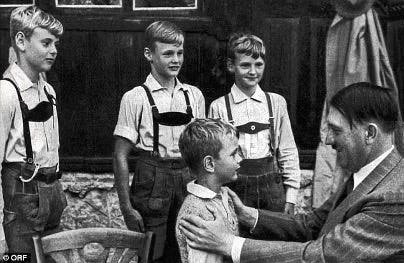“I am beginning with the young….” Adolf Hitler reportedly said, “With them, I can make a new world.” Whether or not conservative politician Hermann Rauschning’s recollection can be trusted, this remark captures Hitler’s attitude towards German children. He was aware that for the thousand-year Reich to become a reality, the torch of Nazi ideology would have to be passed down to future generations.
This insight was not uniquely Hitler’s. Many purveyors of dehumanizing propaganda recognize the importance of capturing the minds of the young. In a recent example, Ethiopian cleric Daniel Kibret, an immensely popular Christian leader and advisor to the Ethiopian prime minister, spoke of the importance of infecting young minds with the view that Tigrayans are cannibalistic monsters that should be exterminated.
I’ve been investigating dehumanization for around sixteen years now, and one of the things that I’ve learned is that dehumanization does not come naturally to us. We are supremely social animals that are exquisitely sensitive to cues of our common humanity. Consequently, we can’t help “seeing human” when we encounter other human beings. This happens automatically, and there’s no mental switch we can flick to turn it off.
Seeing humanness inhibits violent aggression, especially lethal aggression. There is an expanding literature showing that psychologically normal people have difficulty killing others, and that those who do take human lives of others—say, in combat—often suffer psychological harm (inaptly named “moral injury”) as a result.
To dehumanize others, then, we’ve got to rein in, override, or suppress our gut-level responsiveness to them as fellow humans.
To explain how this happens, we must go beyond the human mind. We’ve got to look to the social environments in which human minds exist. In particular, we’ve got to consider the phenomenon of epistemic deference. Human societies rely on a division of cognitive labor. Some individuals are granted the status of experts whom the rest of us look to for guidance. These are the people who are supposed to know.
Expert theoretical knowledge often flies in the face of commonsense beliefs. For example, physicists tell us that the seemingly gapless surfaces of tables and chairs mainly consist of empty space. It’s rational to defer to the physicists, even though we can’t actually see tables and chairs in this way—because the physicists are the ones who are supposed to know.
Ideally, the people who are supposed to know really do know, and we are therefore right to have faith in their expertise. The problem is that many people who do not know or who intentionally promote misinformation also assume the mantle of epistemic authority. These people might be scientists, politicians, celebrities, scientists, religious leaders, culture-war gurus, and the like. Such people can lead us into grave error, sometimes disastrously so, when their authoritative pronouncements are in the service of dangerous political ideologies.
The illustration below is from the hugely successful 1854 book Types of Mankind, a foundational text of the American school of ethnology. This book, which went through eight editions in only three years, was written by members of America’s intellectual elite. The contributors were distinguished scholars, acknowledged experts in their fields. They included the physician Josiah Nott, the Egyptologist George Glidden, and the biologist Louis Agassiz. These men were supposed to know, and given this it was a rational choice for non-specialist readers in 1854 to defer to their views.
But Types of Mankind not only promoted false views, it is a blatantly racist and dehumanizing text. It assures readers that each of the human races evolved independently from the others, and therefore that “differences between distinct races are often greater than those distinguishing [non-human] species.” One of the authors, Josiah Nott, had previously written, in the same spirit, “At the present day the Anglo-Saxon and Negro Races are, according to the common acceptation of the term, distinct species, and that the offspring of the two is a hybrid.” Of course, the authors of Types were not just concerned with racial difference. They ordered the human races on a hierarchy, and no one gets a prize for guessing which one they claimed to be superior to all the others. Pronouncements like these stamped racist and dehumanizing beliefs with the imprimatur of scientific authority. I do not mean to imply that dehumanizing beliefs are just mistaken ideas. Dehumanizing rhetoric is aimed at influencing a target audience by appealing to their material interests, and motivates acts of violence against those deemed to be subhuman. I will discuss these aspects of dehumanizing rhetoric more fully in another post.
Epistemic deference is indispensable for the growth and transmission of human culture, but our dependence on experts also makes us vulnerable to dangerous ideologies and the horrific acts that can flow from them.
Children are particularly vulnerable to dehumanizing propaganda because they are dependent on the adults around them. They are are naturally open to influence, because they must build up a picture of the world using materials supplied by their elders. Children’s epistemic dependence on adults, their openness to influence, makes room for propagandists to colonize their minds.
The photograph below was taken in Fort Lauderdale, Florida, in 1936. It shows the corpse of a homeless tenant farmer named Rubin Stacy surrounded by spectators. Stacy was accused of threatening a White woman with a pen knife, and was arrested. The next day, he was lynched by a mob that may have included the sheriff and his deputies. Stacy was handcuffed and hung with fence wire. His lifeless body was riddled with bullets.
Kristina DuRocher begins her superb book Raising Racists: The Socialization of White Children in the Jim Crow South with a discussion of this iconic photograph. She draws our attention to the spectators.
Several white girls in their Sunday dresses stand around Stacy’s body, their whiteness framing him. Perhaps the most shocking element of the photograph for the modern viewer is the expressions on the girls’ faces. The children do not appear to be traumatized, upset, or even concerned; indeed, the girl on the right looks intently at the body with a smile on her face. Another girl peers around the tree for a better look at the corpse, while the youngest, who appears to be three or four years old, calmly gazes at the camera….Such images and reports attest to the normalcy of white children attending events of racial violence during Jim Crow segregation. Countless other images of lynchings included boys and girls, from a few years old to teenagers, enjoying these public spectacles both during and after the violence….White southerners realized that the primary way to forge solidarity strong enough to maintain segregation was to indoctrinate white youth into the racial order.
After the civil war was lost and slavery ostensibly abolished, White southerners re-enslaved African Americans through means such as sharecropping, convict leasing, and the terror of lynching (which often involved torture, bodily mutilation, and death by burning). And they targeted children’s minds to preserve the legacy of vicious White supremacism that underwrote these acts of violence. DuRocher discusses how this was done by means of community youth groups such as the Children’s Ku Klux Klan, by participating in church plays, and by new school textbooks that affirmed the White supremacist cause. She writes:
The newly printed textbooks of the South applauded the history of white men while simultaneously discussing blacks only in the context of inferiority and ineptitude…. Reference works joined school history texts in lending authority to a view of African Americans’ inferiority, as these materials categorized the black race as similar in appearance and thought to animals.
Something similar happened in Germany. Hitler (who greatly admired American racism) understood that Nazi ideology would prevail only if it could be passed down to the next and future generations. German children’s view of the world had to be brought into line with the Nazi worldview. The regime implemented this through various means, including youth organizations like the Jungvolk, the League of German Girls, and the Hitler Youth. And very importantly, through educational reform. Existing textbooks were withdrawn, and new ones took their place. The curriculum was restructured so that German youngsters received regular lessons in “racial science” that affirmed the superiority of the Aryan race over the lowly, subhuman races—especially, the supremely malevolent Jewish race.
Where successful ideologies go, the invisible hand of the market often follows. Before long, businessmen noticed that dehumanization can be monetized. Some of these products were aimed at juvenile consumers.
This is a picture of a board game that was released in Germany in 1938 or 1939. It was called Jüden Raus! (“Jews Out!”). Described in advertisements as an “up-to-date and outstandingly jolly party game,” its object was to round up and expel Jewish people (represented by grotesque wooden pieces) from a walled city. Meanwhile, in the United States, there were several games on the market that had the object of shooting Black children. To provide some context, at this time the plan was to force Jews to emigrate rather than to exterminate them. That’s why in the right-hand corner the expelled Jews are sent off packing to Palestine.
This is one of many American games that revolved around the theme of killing of Black people. In every example that I have seen, the victim is male. There were also children’s books to drive the racist points home.
To enslave young minds, children must be told what to believe by those who are supposed to know, surrounded by affirmations and apparent confirmations of those beliefs, and deprived of anything that might call the beliefs into question. Today, in the United States, there is a battle going on over what children may and may not be taught in school. Once again, this battle is largely about race. Books offending conservative sensibilities have been purged from curricula and removed from library shelves, and panic about “Critical Race Theory” (a term that has come to mean teaching anything about race that conservative watchdogs don’t like) threatens educators with enhanced surveillance, and punishment if it is discovered that they do not tow the line. At I write these words, there are nineteen states with rules or laws regulating how racial issues can be taught in public schools. And they’re not all limited to the former confederacy.
It is ironic but entirely expectable that at the very moment when American citizens are beginning to seriously confront awful truths about our history and society, there is a strident campaign to shut this down.
For reasons that I trust are obvious, this must not happen.










